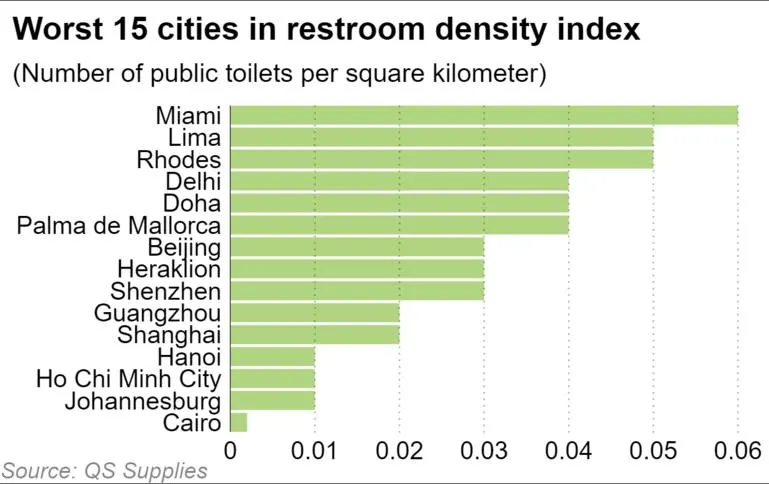The number and quality of public toilets in major cities in Vietnam are not meeting the demands from both the locals and tourists, leading to other hygiene problems.
The ugly fact
According to a recent report by Nikkei Asia, Vietnam's two major cities rank near the bottom out of a total of 69 cities around the world in terms of toilet density per square kilometer. Ho Chi Minh City, along with Hanoi, are ones of the cities where it is most difficult for tourists to use the toilet during their vacation.

According to statistics on the VOV website, the whole city of Ho Chi Minh City has only over 200 public toilets out of a total population of about 10 million people. In 2016, Ho Chi Minh City implemented a project to build 1,000 public toilets in the area, but so far, the project is still on paper, the reason is that there is no land to build. Most of the public toilets are concentrated in the inner city but the number is too small compared to the demand, while the density is too sparse, making it difficult for residents and tourists to access. Degradation or misuse is also affecting the access to public toilets of those in need.
Or Hanoi, an urban area with more than 8 million people, has only about 400 public toilets. Each public toilet has a construction cost of not less than 200 million VND. However, many toilets have deteriorated, leaking water, or there are toilets that have been put into use for a long time, the exhaust valve system has problems, so every time cleaning has to be manually pumped, and some toilets cannot be used. Facing the situation of both shortage and overload, Hanoi has called for socialisation and installation of public toilets, however, after nearly 6 years, the plan to build 1,000 public toilets also failed for many reasons. In addition, of the public toilets in Hanoi, there are 263 fixed toilets, mainly distributed in alleys, serving people in residential areas and collective areas. Only more than 100 public toilets are assembled with steel arranged in public places such as bus stops, parks, flower gardens, amusement parks and other public entertainment. Meanwhile, the demand for public toilets throughout the city is very high, and there are thousands of roads in the inner city, only in the 4 inner city districts of Ba Dinh, Hoan Kiem, Hai Ba Trung, and Dong.
Da Nang, one of the cities that attracts a lot of tourists, cannot avoid the same situation. Along the coastal route of Hoang Sa - Vo Nguyen Giap - Truong Sa, there are more than 10 free public toilets, but most of them are degraded, damaged, unusable or frequently locked. Some public toilets that are still "open" to serve people are also in a dirty and unhygienic state.

The "smelly" consequences
Due to the lack of public toilets and the low quality, many people are less willing to use them, but instead, "doing business" in quiet areas on the street, hence affecting the beauty of major cities as well as the quality of life of the locals.
Many people who don't want to use the public toilets but also not urinating in public, have to go to a coffee shop nearby, purchase a small item, so they can use the toilet for free. Or some people will try to find the nearest shopping malls to use their toilets as they are normally free and cleaner. This is however not so easy for tourists without the knowledge about the local area, making going to toilet in public while visiting Vietnam a negative point.

Immediate actions
From February 1, 2017, Decree 155 of the Government on sanctioning of administrative violations in the field of environmental protection officially took effect. The act of urinating or defecating at the wrong place in the apartment, commercial, service or public places will be fined from 1 million to 3 million dong. However, it is extremely difficult for the local police to catch people and fine them for this violation, hence urinating or defecating in public places is not difficult to be found in Vietnam.
On March 19th, 2023, the Department of Tourism and the Tourism Association of TT-Hue province coordinated with Hue city departments and agencies to organise a ceremony to launch a program to join hands in building a tourist environment, providing support for free sanitation facilities for tourists on the routes. After 1 month of pilot implementation of the program, by mid-March 2023, Hue city departments mobilised to support 138 free sanitation points on 56 routes in 13 central wards that regularly have many tourist activities.
In Ho Chi Minh, in March 2023, the city aims to identify at least 10 locations on key roads of each ward with a high concentration of population and tourists, then encourage owners or management units of businesses on these routes to support and create conditions for people and visitors to use their toilets for free and place signs according to the form. Currently, District 1 People's Committee has set up 100 positions in the district, installed signs to support residents and visitors to use toilets for free. In the next period from April 2023 to the end of 2025, District 1 will continue to encourage owners or management units of business establishments and businesses to support, establish a network of toilet locations of owners or management units of business participating in the movement to serve the management, disseminate and widely inform this network by information technology and mass media so that people and tourists can easily recognise, access and use when needed.
Source: the Internet
